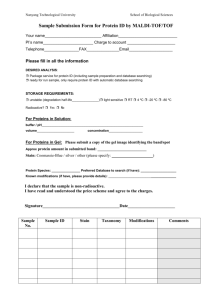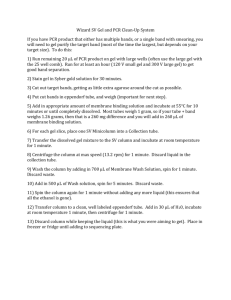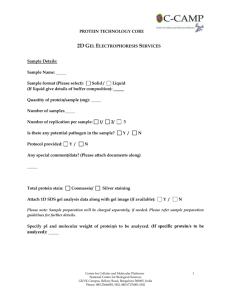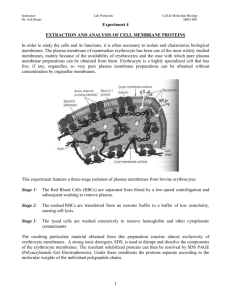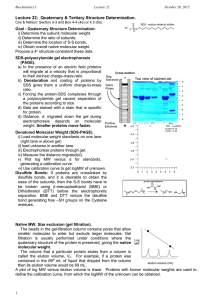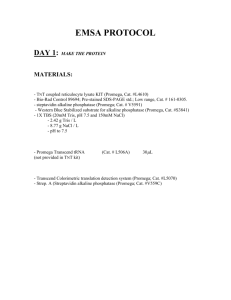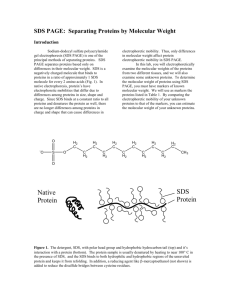Bio. 10 Lab. “PROTEIN GEL ELECTROPHORESIS”
advertisement
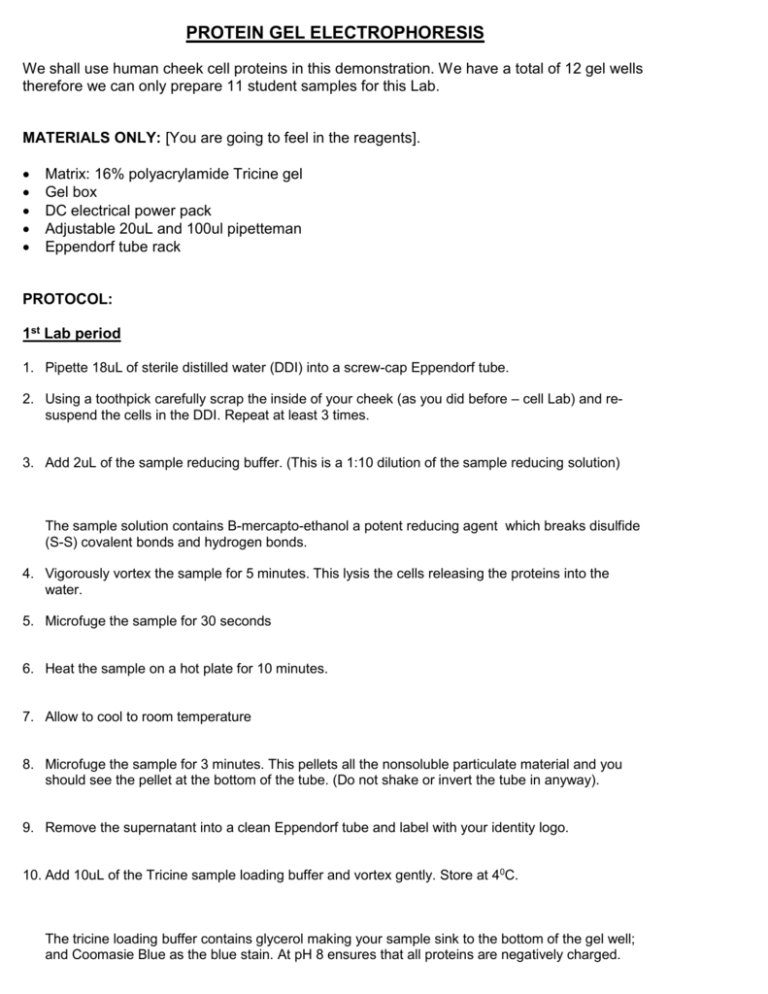
PROTEIN GEL ELECTROPHORESIS We shall use human cheek cell proteins in this demonstration. We have a total of 12 gel wells therefore we can only prepare 11 student samples for this Lab. MATERIALS ONLY: [You are going to feel in the reagents]. Matrix: 16% polyacrylamide Tricine gel Gel box DC electrical power pack Adjustable 20uL and 100ul pipetteman Eppendorf tube rack PROTOCOL: 1st Lab period 1. Pipette 18uL of sterile distilled water (DDI) into a screw-cap Eppendorf tube. 2. Using a toothpick carefully scrap the inside of your cheek (as you did before – cell Lab) and resuspend the cells in the DDI. Repeat at least 3 times. 3. Add 2uL of the sample reducing buffer. (This is a 1:10 dilution of the sample reducing solution) The sample solution contains B-mercapto-ethanol a potent reducing agent which breaks disulfide (S-S) covalent bonds and hydrogen bonds. 4. Vigorously vortex the sample for 5 minutes. This lysis the cells releasing the proteins into the water. 5. Microfuge the sample for 30 seconds 6. Heat the sample on a hot plate for 10 minutes. 7. Allow to cool to room temperature 8. Microfuge the sample for 3 minutes. This pellets all the nonsoluble particulate material and you should see the pellet at the bottom of the tube. (Do not shake or invert the tube in anyway). 9. Remove the supernatant into a clean Eppendorf tube and label with your identity logo. 10. Add 10uL of the Tricine sample loading buffer and vortex gently. Store at 40C. The tricine loading buffer contains glycerol making your sample sink to the bottom of the gel well; and Coomasie Blue as the blue stain. At pH 8 ensures that all proteins are negatively charged. 2nd Lab Period 1. Load all 30uL sample into one gel well using a 100uL pipetteman. 2. One well will be reserved for the pre-stained molecular weight standards. This is to make molecular weight estimation of your sample possible. [See attached page]. 3. Run the gel at 150 volts. 4. Stain and destain with the fast silver stain. 5. Count the number of proteins resolved and estimate their molecular weights. 6. Question: Are the profiles similar? Do you think they are identical in molecular weight and composition or not? Example Protein bands have different mobilities depending upon the SD5-PAGE buffer system used. The apparent molecular weights of the protein bands in the SeeBlue® Plus2 PreStalled Standard are listed below for several buffer systems. For more information on this phenomenon, and molecular weight estimation using SD5-PAGE, contact technical support (see previous page) or refer to the article "Molecular weight estimation of proteins by gel electrophoresis revisited" in the October 2003 issue (volume 25.3) of Focus®, available from www.invitrogen.com. 1. Protein Approximate Molecular Weights (kDa) TrisGlycine Tricine Myosin 250 210 188 191 Phosphorylase 148 105 98 97 BSA 98 78 62 64 Glutamic Dehydrogenase 64 55 49 51 Alcohol Dehydrogenase 50 45 38 39 Carbonic Anhydrase 36 34 28 28 Myoglobin Red 22 17 17 19 16 16 14 14 Aprotinin 6 7 6 n/a Insulin, B Chain 4 4 3 n/a Lysozyme NuPAGE® NoveX® Bis-Tris 4-12% Gel NuPAGE® NuPAGE® MES MOPS
